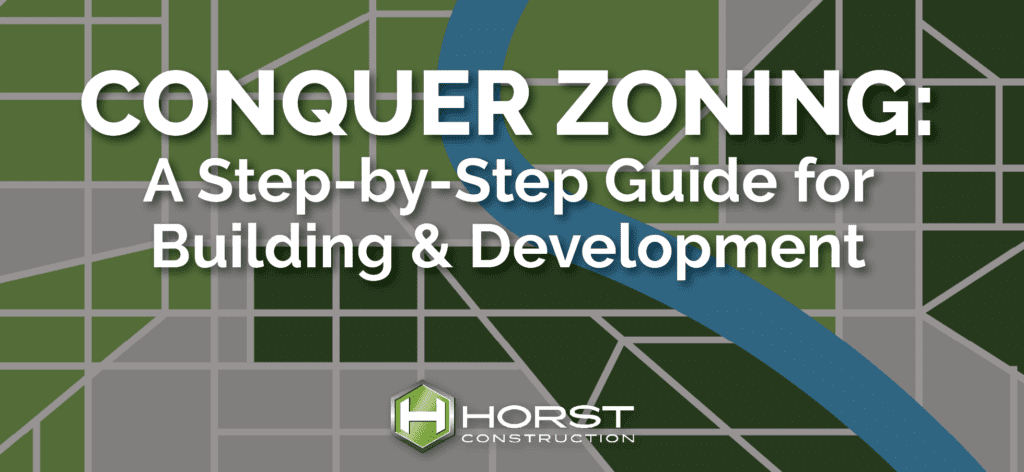
There’s a lot to consider during the ideation phase of a development project: size, financial factors, material selection, and more. But there’s another vital aspect that can often get overlooked: zoning.
Even if your building location is zoned according to your needs, these codes can have a significant impact on the decisions you make for your new development. We’re here to help get you acquainted with the practice and share what you need to know before diving in.
Before we get into it, we want to stipulate that zoning methods and regulations vary across communities. This blog is a jumping-off point, and you should consult your local municipalities and zoning experts for specifics on your project.
1. Understanding the Basics: What Zoning Is & Why It’s Important
Zoning is the process by which municipalities break up sections of land. Each section, or zone, permits specific uses. This is done to help guide growth and planning, ensuring available land is developed responsibly and in a way that is compatible with the town or city.
There are a few different ways zones are broken down[1]. Each city can utilize more than one of these types of zoning.
- Functional Zoning: This breaks down lands by the type of activities permitted in the area, which leads to zones designated for commercial, residential, agricultural, transportation, or industrial uses. It’s typically the most common method of zoning we see in the US. Each zone is subject to specific requirements and regulations that ensure a cohesive and compatible city and town design.
- Form-Based Zoning: This method of zoning divides land based on the physical characteristics of a building as opposed to the activity that takes place inside. This helps create or preserve a certain “feel” or form of a neighborhood. For example, a historic downtown area would allow businesses to be developed right next to townhomes, given that the buildings all contribute to the form of the neighborhood.
- Intensity Zoning: This breaks down land into regions by development density. Some areas may be zoned for high density, like downtown apartment buildings, and others may be zoned for low density, like rural communities. It can also include non-human metrics, like the amount of commercial surface square footage allowed in our building.
- Incentive Zoning: This type of zoning breaks land into regions with and without development rewards. For example, a municipality or government may create an incentive zone over a large brownfield site to encourage development that cleans up and reuses this blighted area. It may also grant developers certain density or usage liberties if they build community amenities like parks and infrastructure.
2. Assemble a Team & Research the Specifics
A knowledgeable and trusted team will prove to be invaluable throughout the development and construction process. Architects, planners, and land-use attorneys can all make valuable contributions when navigating the complexities of zoning laws. Their knowledge should help you ensure the project complies with all local requirements.
Once your trusted advisers are assembled, dive deep into the specific regulations for your area. If you already have a plot of land in mind, explore its zoning codes and the local regulations that accompany it.
You’ll want to take note of specifics like setback requirements, height limitations, and other conditions. Understanding these details early on is fundamental to a project’s success, as it will allow you to adjust your development strategy and expectations to suit codes.
It’s also important to gather site-specific information, such as environmental elements, traffic patterns, and neighborhood characteristics.
3. Conduct Preliminary Meetings
Another secret to successfully navigating the zoning regulations is to work proactively with local planning departments. As early as possible, you’ll want to schedule preliminary meetings to discuss your project, present plans, and gather feedback.
Being proactive will help streamline the approval process as well as identify any issues. This gives you the opportunity to make changes based on their input early in the project process, which is much easier and more cost-effective than leaving it to later stages.
It may also be appropriate to loop the community in on your plans. Whether through informational meetings, press releases, or interviews with local news outlets, highlight how your project will benefit the area. A positive perception in the local community can help with the next stage: gaining permits and approvals.
4. Seek Necessary Permits and Approvals
Your construction partner should help you navigate the process of obtaining all necessary permits and approvals to get work moving. This can include building permits, environmental permits, and special land use permits.
During the application process, it’s important that you have a clear understanding of what information is needed and when. This can help prevent delays and keep your project moving. These packages will typically require plans, environmental impact assessments, and other documents specific to the local municipality.
Before your development project is approved, you may be required to attend public hearings. If this is the case, you’ll want to confidently present your case and address any concerns that the community presents. In some cases, you may need to adapt your approach based on the feedback received. This can demonstrate good faith and positively impact the speed at which the development is approved.
Take the First Step Today
While each municipality can have a unique process and requirements, these steps should equip you with the knowledge needed to navigate the process. Both early preparation and a trusted, knowledgeable team are key to overcoming potential hurdles and achieving your project goals.
Working with a construction team that’s eager to help early in the process can make all the difference. At Horst Construction, our comprehensive preconstruction process facilitated by our team of construction experts can help you jumpstart your development.
Reach out to our team today to get started!
Oops! We could not locate your form.
[1] https://transportgeography.org/contents/chapter8/urban-land-use-transportation/land-use-zoning/


